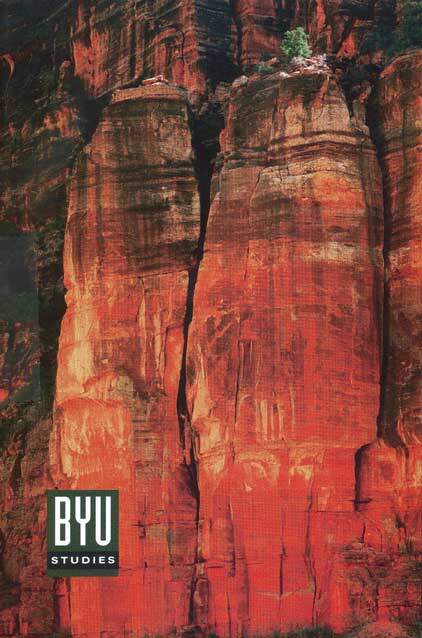Printing in Deseret
Mormons, Economy, Politics, and Utah's Incunabula, 1849–1851
Review
-
By
Craig L. Foster,
RICHARD L. SAUNDERS. Printing in Deseret: Mormons, Economy, Politics, and Utah’s Incunabula, 1849–1851: A History and Descriptive Bibliography. Salt Lake City: University of Utah Press, 2000. xv; 213 pp. Illustrations. $35.00.
The field of “book history” has been described as “‘the social and cultural history of communication by print’ whose purpose ‘is to understand how ideas were transmitted through print and how exposure to the printed word affected the thought and behavior of mankind.’”1 Richard L. Saunders, curator of Special Collections and Archives at the Paul Meek Library, University of Tennessee at Martin, has crafted a well-written study of the history of printing in early Deseret.2 In the process, Saunders, much like other historians of the printed word, has studied the social and political influences on Utah’s printing efforts.
In the introduction, Saunders announces three themes that “shaped the conduct of printing in Deseret and Utah’s first years.” These themes are “Mormon social maintenance and reconstruction, the economics of the saints’ isolated refuge and the California gold rush, and the quest for national political recognition” (xv). In the first part of the book, he describes the Saints’ efforts to establish a press in Utah as well as create a political state in their new Great Basin kingdom.
Early printing efforts centered around economics (such as printing currency for the new community and publishing advertising handbills), ecclesiastical business (such as publishing epistles from the First Presidency of The Church of Jesus Christ of Latter-day Saints), and educational and political publications (such as the charter of the University of Deseret and the Constitution of the State of Deseret, both of which were published in 1850). Naturally, other printing efforts were initiated, most important of which was the Deseret News. Further printing jobs included announcements for entertainment, the Deseret Almanac, and George D. Watt’s Exercises in Phonography.3 However, not surprisingly, a high percentage of early printing emphasized the fundamentals of creating a community and state in the desert.
Potentially the most significant and lasting contribution to the study of printing in early Utah is the second part of the book, “A Descriptive Catalogue of Utah’s Earliest Imprints,” which covers the years 1849 through 1851. The entries include bibliographic information, descriptions of the contents of each publication where known, and miscellaneous information concerning the item and events surrounding the publication. This valuable section alone is worth the price of the book.
With any work of this nature, there will be strong and weak points. For example, while Saunders went to great effort to describe the background of the first printers, he left out some pertinent information, such as the illnesses and cause of death of Joseph Cain (69). Information on that topic might have been obtained through searching ward records or Deseret News obituaries. If nothing could be found, Saunders should have so stated, since Cain is a prominent figure in the book. Another instance in which Saunders’s good information could have been made more complete is in his discussion of the 1851 political crisis. Runaway official Broughton D. Harris, federally appointed territorial secretary of state, left Utah Territory without the official seal because he had been threatened by pursuit and arrest if he took the seal with him. Harris left the seal “in the keeping of a non-Mormon merchant” (79). The name of the merchant ought to be given: since he was the holder of the territorial seal, his name is probably recorded.
These minor problems aside, the book is a good scholarly work that has generously used both primary and secondary sources on this subject. Most of all, the book has demonstrated the incalculable importance and effect of the press and printing in Utah’s formative years. Printing in Deseret, especially its descriptive catalogue, will be a valuable addition to public and research libraries as well as to the personal collections of scholars of early Utah and Mormonism.
About the author(s)
Craig L. Foster is a Research Specialist at the Family History Library of The Church of Jesus Christ of Latter-day Saints, Salt Lake City. He received a B.A. in history (1986), an M.A. in history (1989), and an MLIS (Master of Library and Information Science, 1991), all from Brigham Young University.
Notes
1. Robert Darnton, “What Is the History of Books?” Daedalus 3 (summer 1982): 65, as quoted in David J. Whittaker, “The Web of Print: Toward a History of the Book in Early Mormon Culture,” Journal of Mormon History 23, no. 1 (1997): 4.
2. “Deseret” was the name Church members first proposed for the settlement that later became Utah Territory. The name, taken from the Book of Mormon (Ether 2:3), means “honeybee.”
3. George D. Watt, Exercises in Phonography: Designed to Conduct the Pupil to a Practical Acquaintance with the Art (Great Salt Lake City: W. Richards, 1851).
- Russia’s Other “Mormons”: Their Origins and Relationship to The Church of Jesus Christ of Latter-day Saints
- Joseph Smith’s Cooperstown Bible: The Historical Context of the Bible Used in the Joseph Smith Translation
- “Sweeping Everything before It”: Early Mormonism in the Pine Barrens of New Jersey
- Young “Tony” Ivins: Dixie Frontiersman
- Edward L. Hart: A Conversation about Poetry
- Mormons in the Press: Reactions to the 1901 Opening of the Japan Mission
Articles
- Finding Biblical Hebrew and Other Ancient Literary Forms in the Book of Mormon
- Strengthening Our Families: An In-Depth Look at the Proclamation on the Family
- Encyclopedia of Latter-day Saint History
- Till Debt Do Us Part: Balancing Finances, Feelings, and Family
- Historia de los Mormones en Argentina: Relatos de pioneros
- City of Roses
Book Notices
Purchase this Issue
Share This Article With Someone
Share This Article With Someone
The Lynching of an American Prophet
Print ISSN: 2837-0031
Online ISSN: 2837-004X


